This article was created by i-D Mexico.
In South Korea, as in many conservative parts of the world, the queer community still finds ways to express itself. Away from the gaze of traditional society, in the Itaewon neighborhood of Seoul, you can find a creative and expressive drag scene that put down roots several years ago. Photographer Kanghyuk Lee, a.k.a. Snakepool, captured seven of the most sensational drag queens in the community, and i-D asked them how they live on their own terms, regardless of the old rules.
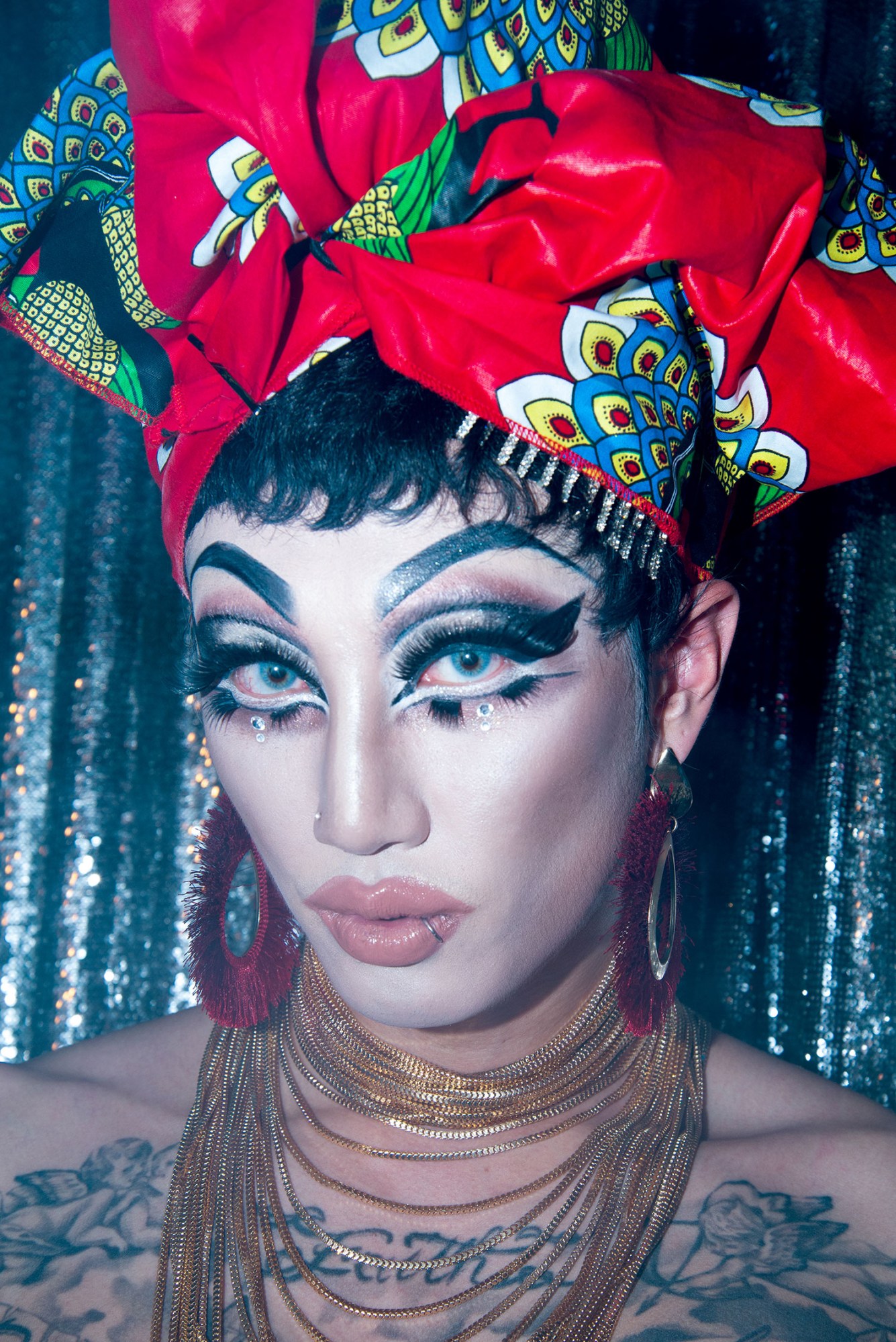
NANA, 32, Busan
What do you do?
I have a full-time day job, and I’m a drag queen at the weekend.
When and why did you first begin to experiment with drag?
The first time I found out about drag was when I watched the movie Hedwig. After that, I began participating in drag by performing at a gala show in a small theater at Hongdae district. I studied theater at college, so I had the chance to get to know about drag while learning acting. To me, drag seemed like a medium that allowed the expression of another version of myself that’s kept inside, which appealed to me and pushed me forward with participating in drag.
Do you find yourself discriminated against often because of what you do?
While it is true that drag culture has become an established culture in Korea and there are a lot more drag queens than before, when I first entered the scene eleven years ago, drag queens were very unfamiliar in Korea. Even within gay culture, people were skeptical about our intention to dress up as women. However, things have changed, and now drag is seen as a way of self expression, allowing us to fully enjoy ourselves.
What message do you want to send to people through your drag?
Drag is a way of self expression. Aside from your external self, there is something that’s locked inside you. Something that has always been in your thoughts. And drag is what lets you take it out and express it. There are no set frames or ways for drag. Enjoying self expression and sharing such joy with others are just what I want.

Kuciia Diamant, 28, Busan
What do you do?
I used to work with a friend who ran an online store, but now I am a full-time drag queen. I do everything I can as a drag queen, including performing on stage, photo shoots, interviews, etc.
How would describe your drag alter-ego?
I see my drag character as hope. Five years ago, queer culture festivals in Korea were receiving a lot of attention from the public, for better or worse. It was during that time I debuted, and by participating in human rights rallies as well performing at clubs, I think I became a drag queen that gives hope to others. I still work hard to embrace other people’s feelings with my drag character. On the outside, I want my character to shine just like my name Diamant (Diamond).
What would be a safe space for people to be themselves in Seoul?
Itaewon, where I currently reside. Many friends of mine feel the same. Among the many small and large cities in Korea, Itaewon is the place in which our culture has laid down its roots. It is the place I feel most comfortable walking with other queens.
What message do you want to send to people through your drag?
As a child, I was timid and a loner. I was bullied in school, and didn’t have many friends. But considering how much confidence and courage I gained after beginning drag, and thinking about all the people I met along the way, I could say that drag was a huge challenge for me, and also an invaluable treasure that changed my life. Not just something that makes you look cool. Some of you who are reading this might be going through a rough time, just like my childhood. To those, I’d like to say give it a try! Whether it’s drag or some other thing that you only dreamed of, just give it a try. It will change your life!
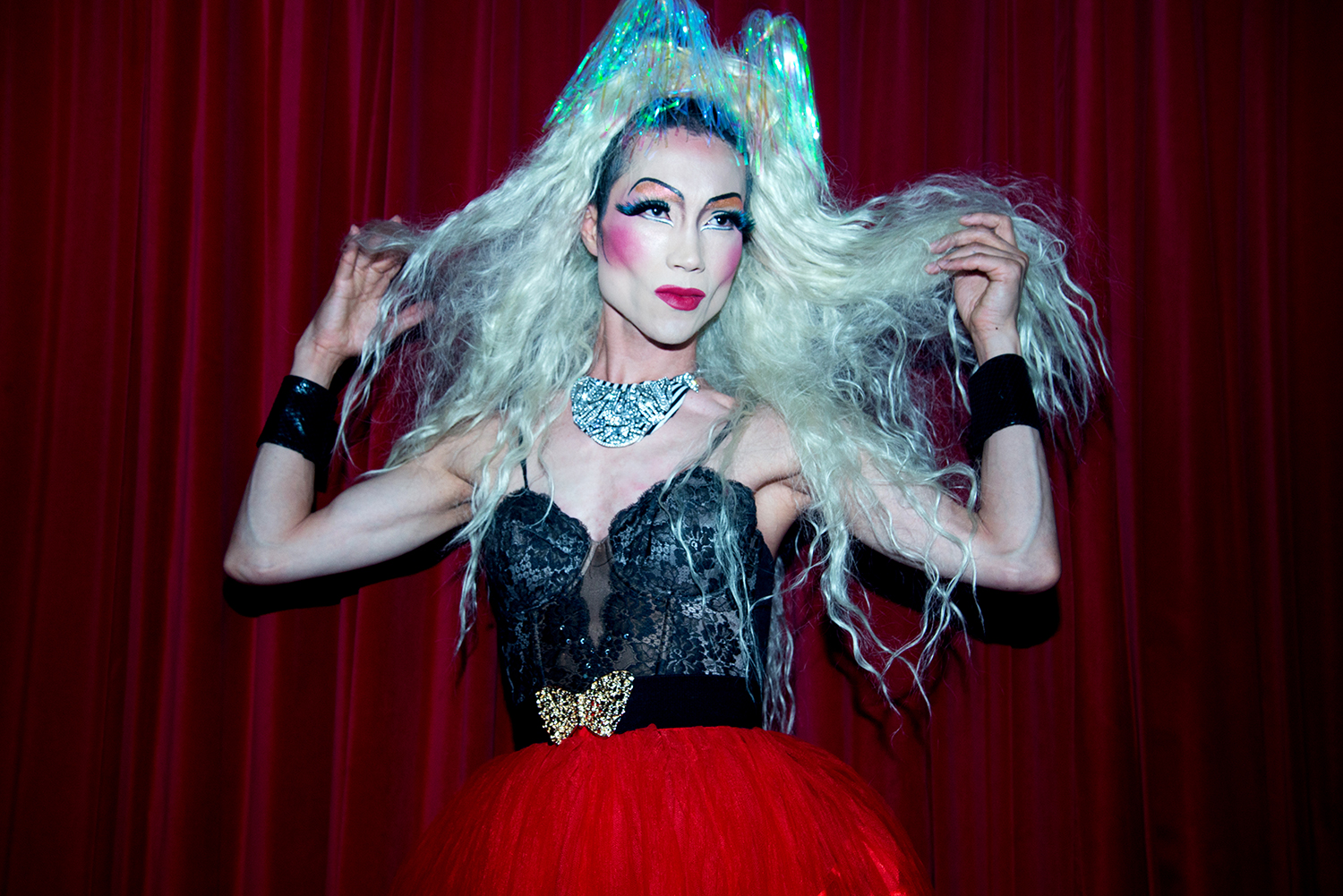
More, 39, Seoul
What do you do?
I’m a dancer.
How would describe your drag alter ego?
Spick and span, and extremely ordinary and universal.
What is the greatest obstacle you had to overcome to become a drag queen?
At the turn of the millennium, when I first began drag, everything about it, even the term itself, was new and unfamiliar in Korea. We were seen as just men dressed as women, or, as the term transgender caught up with the public, they regarded us as transgender women in dresses. Every time I went on stage, it was painful and humiliating to disguise my feelings behind fancy outfits and entertain the audience. Now, however, the sheer beauty of drag helped liberate myself from many things.
What has been your biggest triumph as a drag queen?
The Amsterdam Rainbow Dress in Seoul. Amsterdam Rainbow Dress is a work of art that was created by four Dutch artists, with support from Amsterdam Museum and COC Amsterdam. The dress is made of 80 national flags from countries where homosexuality is regarded criminal and punishable by law. If any of the countries whose flag is on the dress repeals existing anti-homosexual law, its flag is replaced with the rainbow flag. The dress embodies our wish that one day, rainbow flags will be the only flag it carries. The flag was shown in Europe and the United States in the past. This year it made it to Korea, which is the first country in Asia. I have been a drag queen for 18 years, and it is an honor to participate in this meaningful event.
How could things be better for the queer community in Seoul?
The queer scene in Korea is too narrow (mostly night culture) and geographically limited too (in Seoul, the scene is mostly confined to Jongno and Itaewon). Also, the gay scene overshadows lesbian, transgender, and other minority scenes. I would like to all of them rise to the surface. I want to see queer people walking around under daylight, in the streets, on the subway, even at local community centers.
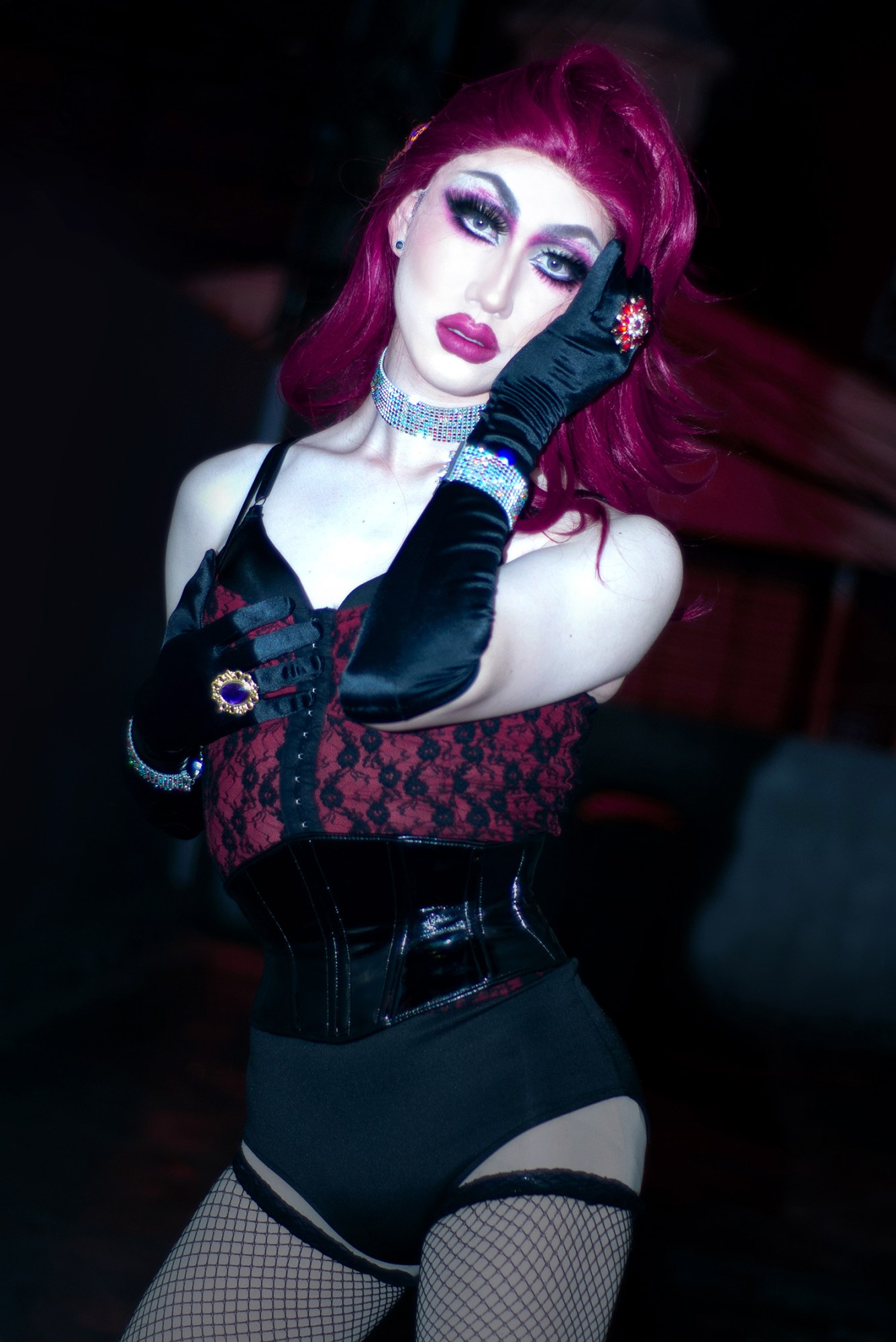
Erica Balenciaga, 22, Incheon
What do you do?
I am currently taking a gap year from college. I started working in Korea as an English teacher, but currently I’m a stay at home housewife and full-time drag queen.
How would you describe your drag alter ego?
I would say that Erica is the embodiment of everything that empowered me while growing up. I see Erica as a confident and glamorous Asian superstar. Being Korean, I listened to K-Pop at a very early age when stars like Lee Jung Hyun, BoA, and Lee Hyori were dominating the charts. Seeing how their unique styles paved the way for K-Pop to grow and become mainstream really inspired me, and I wanted to be like them. It’s difficult to say that I have developed a solid drag character. But the very essence of being able to evolve my style and reinvent myself through Erica is what brings me joy.
When and why did you first begin to experiment with drag?
I was born into a family of Jehovah’s Witnesses so from the very beginning, I wasn’t allowed to openly express my sexuality or artistic vision. I was scared to come out and was continuously ridiculed for liking female K-Pop groups and gay icons like Madonna, Lady Gaga, and Christina Aguilera. Even the way I looked and dressed — skinny jeans and BB cream — made the elders in my church very concerned. That’s why for a majority of my life, I had to live a double life.
It was only when I went to college, that I started wearing bolder makeup to school and became more involved in the LGBTQ community. Sophomore year of college was also when I started doing drag and getting booked for performances. I would say that I leaned toward wanting to look more “feminine” when I started doing drag. I didn’t use any theater makeup and relied on products made for daily wear. When I met my drag mother and sister in Shanghai, they taught me more tricks like contouring, blending, cinching, and padding that completely revamped the way I wanted to look. Now I go for a more exaggerated appearance and am not afraid to show a crazier side of me in performances. I think continuously performing really helped me open up and channel a more comedic side that I never knew I had. While I thought I had the “look” down, I realized that there’s so much more to being an entertainer. Stage presence and audience interaction didn’t come to me naturally but I was able to finesse my skills by really pushing myself to go further with my drag.
Who in your community helped you become who you are now?
The college that I went to was located in Shanghai, so for two years, I lived away from Korea. I had no idea that an LGBTQ or a drag scene for that matter existed in Korea. For awhile, I followed several queens of Seoul through social media and saw how quickly the scene was growing there. Imagine how frustrated I felt when I realized that Kim Chi, Naomi Smalls, Violet Chachki, and Detox all had performed in my own country. I knew I had to go back and be a part of the community myself. This was also the time when my drag was starting to take up a big portion of my life. I couldn’t bear living a double life anymore and decided to be honest with everyone. As soon as I told my parents about me being a drag queen, they cut off all contact with me emotionally and financially.
For a period of six months, I worked three jobs and started a fundraising campaign to help pay for my schooling and living expenses. Then I decided to reach out to Kuciia Diamant, one of the only Korean drag queens I knew at the time, to ask for help. She was incredibly supportive and shared my story with the rest of the world. After reconciling with my soon as I landed, I started asking the local queens for opportunities to perform. Charlotte Goodenough, who runs the show at Rabbithole’s Drag Drink Play alongside the iconic drag king Jaxter the Taco Master, booked me for my first ever drag show in Seoul. Since then, I’ve worked with so many amazing queens of Seoul. It is thanks to the amazing and supportive queens like Charlotte and Kuciia, that aspiring performers can have the opportunity to grow. Also, thanks to Hurricane Kimchi, an activist queen in Seoul, I was able to participate in several Pride events. Seoul’s drag scene is growing more than ever thanks to the collective efforts of all these amazing artists.

Vita Mikju , 24, Daejeon
What do you do?
I’m working as a teaching assistant and an administrative officer in university in Seoul.
When and why did you first begin to experiment with drag?
I was always interested in questioning what femininity and masculinity are. South Korea strictly defines how one should act in certain way according to the identity you’re given. Woman or man, minor or adult, junior or senior, young or elderly, etc.
I was asked a lot to act like a man in my whole life. But I always think, “Hey I am being myself, and I’m a man! I AM ACTING LIKE A MAN! What kind of man do you want me to be?” Drag was a perfect form for me to break the rules and prove there’s no such a limit of what and how to act/wear/do/talk for being who you are. You do you.
Do you think drag is a form of protest?
Yes. Korea doesn’t even know LGBTQ+ people exist here. Well some do, but they treat queer people as if we are contaminated trash. And they never listen. They only see what they want to see. Something unfamiliar and uncomfortable, something they have never interacted with: DRAG QUEEN! They never realize the boy next door could actually be gay.
Do you think the skeptics should try drag?
Yes and no. You do you. I’ll do me.
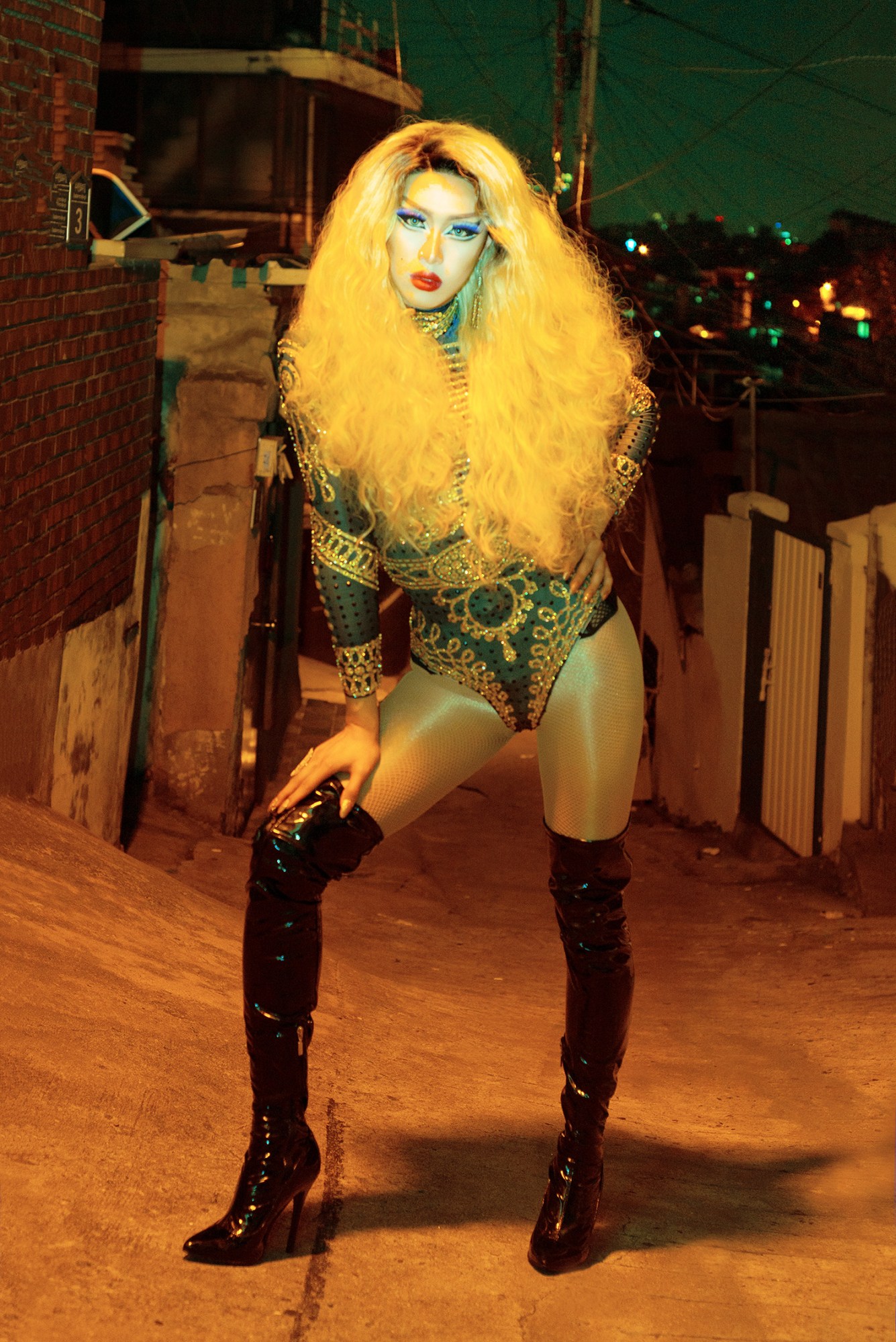
Bori, 25, Cheonan
What’s the most misguided belief about drag queens at the moment?
People often ask, “Are you preparing to become transgender?”
Do you feel discriminated against because of what you do?
Still many people in Korea don’t know about, or don’t understand drag, and often they might say “drag is misogyny.”
How did you decide to do drag?
I was cast through Facebook for a local club’s first anniversary party. I worked there for about six months as a dancer, and later on began drag. In the beginning, I had no idea whatsoever, and didn’t know how to put on makeup. But soon after, I started to do my makeup on my own. And from then on, drag became more and more appealing to me, and as I discovered other sides of me, I continued with drag. I still have a long way to go, and I plan to keep on trying out new things.
What message do you want to send to people through your drag?
I would like people to look at drag queens without prejudice.
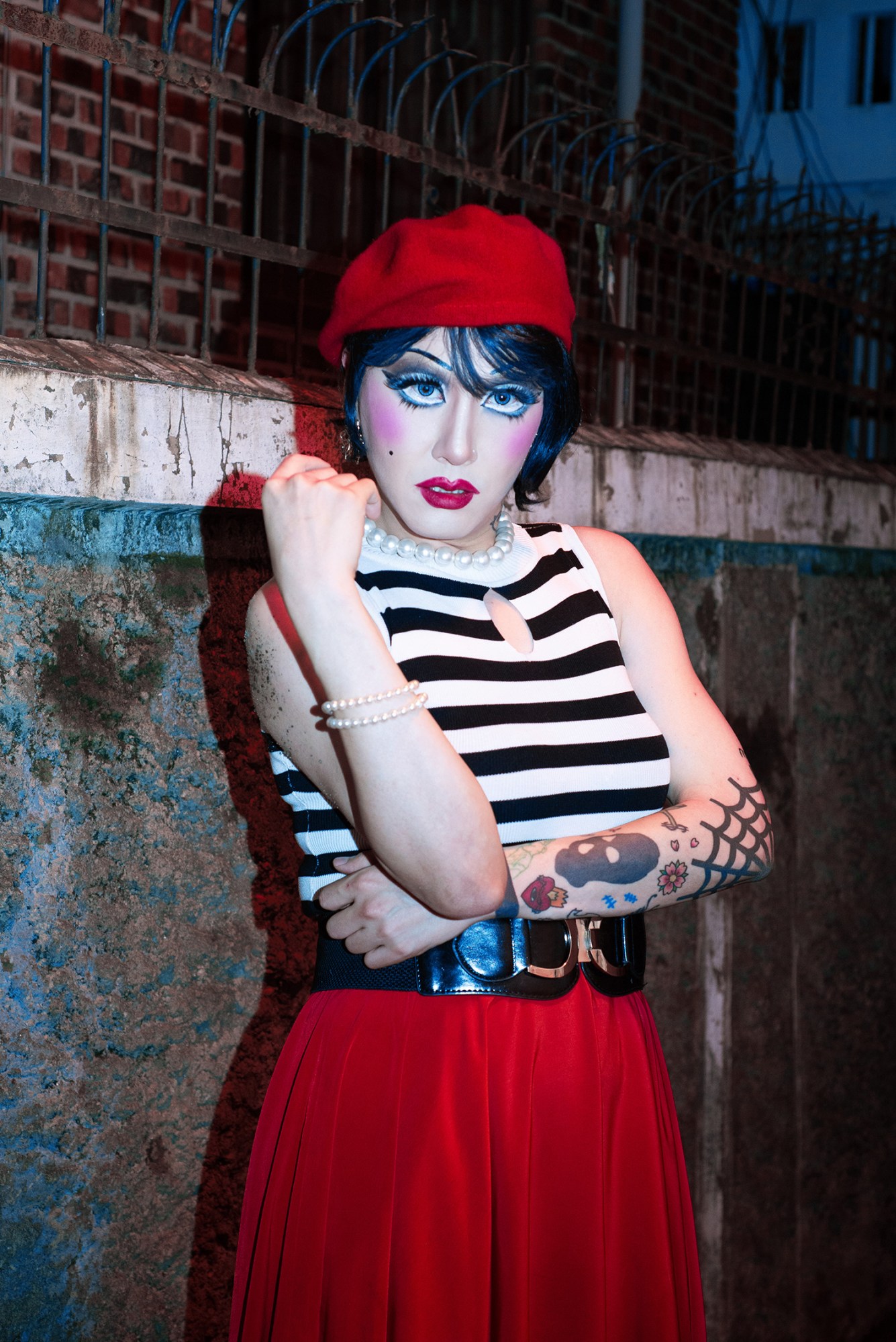
KYAM, 30, Nonsan
Where does your name come from?
It’s been my nickname since I was in high school.
How did you start to do drag?
I studied acting when I was young, and took some time off from college to perform with trans people. We visited “Trance”, one of the oldest and most well known drag queen clubs in Korea, which introduced me to the idea of a drag queen. Afterwards, I performed drag queen shows instead of transgender shows. That was back in 2010. The fact that I could interpret songs and build characters to create my own show appealed to me. I think I’m still drawn to that process of realizing concepts that I kept to myself since I was little.
Do you think drag is a form of protest?
Depending on how you use it, it could be protest or resistance. Personally I would like drag to be more of a performance that would reach the audience in a friendly manner. Maybe this is because I like conveying my personal messages in drag, and dislike causing discomfort to others.
What message do you want to send to people through your drag?
Above all, I want to put on a performance that will allow the audience to cry, laugh, and be consoled. I guess I’m a natural born clown.
Credits
Photography Kanghyuk Lee a.k.a. @snakepool Translation Won Gyeom Choe
This article originally appeared on i-D ES.
